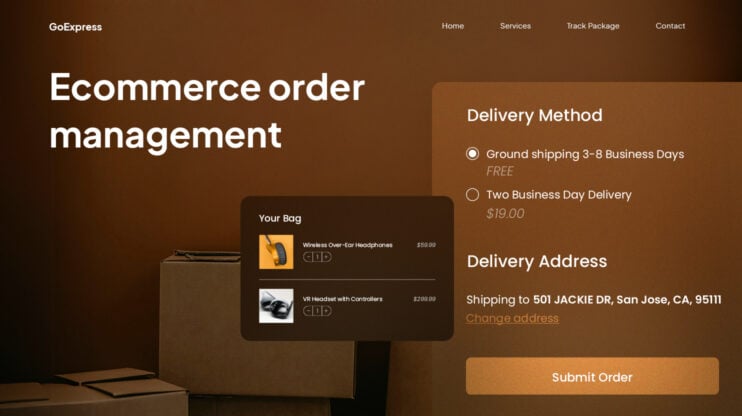Learning how to create a website for affiliate marketing is an investment that builds an easy pathway to passive income, but if it were that easy, wouldn’t everyone be doing it?
Many beginner affiliate marketers suffer from “failure to launch.” The common denominator is often a less-than-optimal choice for the target audience and sub-par affiliate programs.
Successful affiliate marketers know the best way to spin up a high-converting website for affiliate marketing relies on:
- Finding a niche
- Evaluating affiliate programs
- How to create a website for affiliate marketing
- Content and search engine optimization (SEO) that engages and converts
Become a 10Web Affiliate
Get 30% revenue from each new referral for 12 months.
What is an affiliate marketing website?
An affiliate marketing website uses content to promote products or services through affiliate links.
If the site’s content is on-point, visitors are so dazzled and engaged they eventually click an affiliate link. If they make a purchase, the website earns a commission. Out in the wild, that looks something like this:
- You love coffee and know all about the best brewing gadgets (hello, Nespresso!). You possess insider knowledge about what’s good and what’s just good PR.
- You create a website for affiliate marketing, BetterBrewCoffee.com, and join the Amazon Associates program.
- In a blog post titled “Best Espresso Machines for Home Brewing,” you use affiliate tracking links to the espresso machines sold on Amazon.
- A fellow caffeine addict searches on Google for the best espresso machines, finds your post, and clicks an affiliate link.
- You earn a small commission once the visitor purchases the machine on Amazon.
- Rinse and repeat with more high-quality content, and grow your affiliate website’s traffic and profit!
That is a very basic, optimistic version of how an affiliate website works. It glosses over all the thought and planning behind the scenes, but you get the idea. Affiliate websites come in many forms. A successful affiliate site doesn’t have to be huge, although the big media sites are in on it, too.
You just need the right niche where you can leverage your knowledge and expertise to create extraordinary, SEO-optimized content designed to attract traffic that converts.
Examples of successful affiliate sites
So, how do people do it? One way to get an idea of what works is to pick apart some websites for affiliate marketing and see what makes them tick.
GlobalFishingReports.com (Fishing Niche)
- Built on a dropped domain, leveraging its existing authority.
- Combines first-hand experience with strong PR backlinks to build credibility.
- Monetizes through a mix of Amazon Associates and private fishing gear brands.
TheHoopsGeek.com (Basketball Niche)
- Uses multi-vendor product pop-ups to increase conversions by giving users multiple buying options.
- Focuses on comparison-style content (e.g., “Best Basketball Shoes for Jumping”).
- Monetizes through Amazon Associates and direct partnerships with shoe brands.
TheseGoldWings.com (Travel Niche)
- Took advantage of a viral YouTube video to drive traffic and earn backlinks.
- Features a mix of long-form guides, gear reviews, and travel recommendations.
- Uses display ads and affiliate links to monetize.
It’s not all sunshine and rainbows, though. Spammy, low-quality content, or SEO tactics can rain on your parade.
SustainPunch.com (Music Niche)
- Experienced a 50% traffic drop after a Google algorithm update due to low-quality content.
- Relied on thin, AI-generated content with little personal expertise.
- Lacked proper backlinks and authority signals, leading to poor rankings.
What makes a great website for affiliate marketing?
The best websites for affiliate marketing share some important traits:
- They’re run by experts or people who know the niche. The ability to boast true expertise is a ranking factor that also helps conversions.
- Content is high-quality and adds value for the audience. This usually means a mix of informational, educational, and promotional content.
- Backlinks come naturally through YouTube videos, PR mentions, and social proof.
- Sales funnels are optimized and remove all the friction from making a purchase.
- Affiliate programs with higher commissions, better conversion rates, and tempting promo materials.
How do the pros create a website for affiliate marketing?
Affiliate marketing aficionados know that success hinges upon:
- Finding the right niche
- Focusing on the right keywords
- Finding the best affiliate programs
Once you know your target audience, it’s time to create a website for affiliate marketing. This gives you a loudspeaker to publish authoritative content to build trust and credibility. Figuring out how to build a website for affiliate marketing is a hurdle some beginners never seem to cross. But not you, because you’re going to have a plan!
Market research and finding a niche
The first step to creating a website for affiliate marketing is finding a good niche that works for websites both for profitability and longevity.
Start with what you know. If you have expertise or experience in a profession, particularly in a Your Money or Your Life (YMYL) topic, Google’s going to love your content. Honestly, there’s no guarantee, but the search giant does prefer content creators with Expertise, Experience, Authoritativeness, and Trustworthiness (E-E-A-T).
Many successful affiliate marketers agree that scoping out the competition is a great way to get a feel for the lay of the land and zero in on a niche that works for you.
Competitor and keyword research
A little sleuthing for existing affiliate websites in your niche can help you see what works:
- Search Google with ‘Affiliate Disclaimer’ + [keyword] to uncover active affiliate sites monetizing in your niche.
- Reverse-engineer affiliate offers by analyzing backlinks to known affiliate tracking URLs (Amazon, CJ, ShareASale) to identify high-converting niches.
- Explore marketplaces like Empire Flippers to see which affiliate sites are successfully selling for six or seven figures.
Once you see some sites that pique your interest, go deeper. What kind of content do they publish, and what’s it about? You’re looking for a set of related keywords to form the foundation for your website’s content.
Affiliate marketers offer some spicy takes on how to find the best keywords to target and validate their viability:
- Leverage competitor research, search results, Google AutoSuggest, and tools like Google Trends or Pinterest Trends to find relevant keywords.
- Don’t underestimate low-volume keywords. Check out Ahrefs Zero Search Volume keywords. Even keywords with zero searches in tools often perform well.
- Use Ahrefs or SEMrush to tease out the low-competition, high-search-volume keywords where new websites can still gain traction.
Avoiding no-money niches
Not all niches are created equal when it comes to profitability. Some attract the arch-nemesis of affiliate publishers: passionate hobbyists who create free content. These nice folks often publish content without a clear monetization strategy, making it difficult for affiliate marketers to compete. These niches can be the most difficult to monetize.
In addition to over-enthusiasm from hobbyists, certain niches tend to have issues with low commercial intent:
- Video games – Most content is fan-driven, and audiences are notoriously stingy. This audience wants free stuff, and it’s tough to persuade most of them to actually make that purchase, even if they click an affiliate link.
- Gardening – This is a highly community-driven niche, so it’s got that part going for it, but unfortunately, most advice is shared for free on YouTube and forums.
- DIY arts & crafts – Same as above. Most creators share projects out of personal enjoyment (or maybe a need for attention?) rather than to drive sales.
Instead, you’ll need to think outside the box. If gardening is your jam, maybe there’s hope yet. Try niching down and out to find a higher-value product to tie in with.
- Drones – Products like this are surrounded by a lot of interest from hobbyists and professionals. Since they tend to be pricey, they’ve got the high-ticket sales potential that’s generally more desirable. Is drone garden photography a thing?
- Security systems (alarms, cameras) – Recurring revenue through subscription-based products and services is where it’s at. One sale through a high-commission affiliate program could mean long-term value.
- Pet health products – Areas like this are in high demand and have endless product and service choices. These areas tend to have more opportunities for private affiliate programs, too.
When selecting a niche for your affiliate website, follow the money. Look for niches where competitors are raking it in through affiliate programs and other revenue streams.
Finding the right affiliate networks
As a part of the process of finding your niche, you’ll want to make sure there are plenty of options for affiliate programs. The right affiliate network can mean the difference between sinking and swimming.
Major affiliate networks
As for affiliate opportunities, you’ll want to check out the big players initially. Later on, once you have some impressive numbers to show off, you can start applying to private affiliate programs, which often offer better commissions.
- Amazon Associates – This is ideal for beginners but suffers from low commission rates and short cookie durations. Still, lots of affiliate marketers start here to test the waters.
- CJ Affiliate – Features major brands across different industries.
- ShareASale – Well-known for its variety of merchants.
- Impact – Offers premium brands and high-commission programs.
- Rakuten Advertising – Great for global affiliate marketing opportunities.
Some affiliate networks require your website to have a certain number of visitors or traffic to join. Initially, if you have trouble getting into the major networks, Skimlinks is a good alternative. It’s a good starting place to earn commissions from different brands without jumping through hoops.
Niche-specific affiliate programs
Certain industries have dedicated affiliate programs outside of major networks. You’ll often find better commissions and more specialized offers:
- MoreNiche (health & fitness) – High-commission health-related programs.
- AvantLink (outdoor & sports) – Ideal for the heavy-hitting outdoor gear and sports niches.
- FlexOffers (finance & tech) – Great for credit cards, loans, and digital services.
Become a 10Web Affiliate
Get 30% revenue from each new referral for 12 months.
How to evaluate an affiliate program
You don’t have to look far to find affiliates evangelizing about how to judge affiliate programs. (Disclaimer: they may be earning a commission!) They agree on some important aspects:
- Commission rates and cookie durations – Higher commissions and longer cookie windows equal better chances at success.
- Support and resources – Some networks provide marketing materials, training, or dedicated affiliate managers. This can be helpful when planning content and for better conversion rates.
- Product quality and brand reputation – Promoting low-quality products just makes you look bad and destroys credibility.
- Conversion rates and earnings per click (EPC) – Choose programs with proven high conversion rates to minimize the risk of spending time on a project that never takes off.
Relying on a single program can be risky—joining multiple affiliate networks ensures stability and long-term income security.
Legal and compliance considerations
When running an affiliate website, it’s essential to follow legal guidelines and compliance rules set by affiliate networks and local regulatory bodies. Dropping the ball on this can lead to penalties, loss of commissions, or even being banned from affiliate programs.
Key compliance factors:
- Disclosure policies – Many regions, including the U.S., require affiliate marketers to disclose their relationships with companies. The FTC mandates that affiliate links be clearly disclosed to readers. You’ve probably noticed this done with a disclaimer at the top of blog posts or near affiliate links.
- Privacy policy and terms of use – Websites collecting user data or emails (e.g., for newsletters) must include a privacy policy that explains how data is handled.
- GDPR/CCPA compliance – If you collect email addresses or personal information from EU (GDPR) or California (CCPA) users, you need to comply with regulations regarding data storage, user consent, and opt-out options.
- Affiliate program terms – Some networks, like Amazon Associates, have strict policies about how links can be used. Violating these terms—such as using cloaked affiliate links or mentioning prices incorrectly—can result in account termination.
Even though affiliate marketers are legally obliged to let you know about their tracking links, following the rules also helps establish credibility and trust.
Platforms and tools
Some affiliates succeed with social media alone, but experts overwhelmingly recommend creating a website for affiliate marketing. A website provides long-term stability, with an avenue for SEO traffic and multiple monetization options.
Best website builders and platforms for affiliate websites
Choosing the right platform is crucial for performance, SEO, and customization. While various website builders exist, some are better suited to affiliate websites than others:
- WordPress – The most popular and flexible Content Management System (CMS). It’s ideal for SEO, content marketing, and offers deep customization. If you’re wondering how to create a website for affiliate marketing for free, this CMS is your best bet. Paired with 10Web’s AI Website Builder, creating a website for affiliate marketing becomes even easier.
- Shopify & Wix – Better suited for physical product affiliate websites but offer limited SEO and content customization compared to WordPress.

Build your website in 1 minute
Create your dream website with 10Web AI Website Builder
and take your business online!
Why WordPress?
- SEO-friendly – Optimized for Google rankings with customizable plugins like Rank Math or Yoast SEO.
- Full control – Unlike hosted platforms, you own your content and can customize the site however you like.
- Scalable & versatile – Supports multiple monetization options, from affiliate marketing to display ads and e-commerce. Some of the best digital marketing websites run on WordPress.
- Affiliate-friendly tools – Affiliate plugins like Pretty Links or ThirstyAffiliates paired with a responsive, well-supported theme can do some of the heavy lifting when creating a website for affiliate marketing.
Choosing the right domain and hosting
Selecting the right domain name and hosting provider is an art and a science. The goal is to find a domain that’s good for SEO, user experience, and long-term website performance. A fast and reliable hosting provider can mean less headache for you and potentially better rankings in search results.
Domain name best practices
- Brandable vs. keyword-rich domains – A short, memorable domain name (e.g., GearLab.com) is usually better than generic keyword-based domains (e.g., BestLaptopsForGaming.com).
- Keep it short and simple (KISS) – Shorter domain names are easier for users to remember and type.
- Use a .com extension – Unless you want to target a specific country, .com domains remain the world champs.
Hosting providers: quality matters
Your hosting provider plays a major role in website speed, security, and uptime, all of which affect SEO rankings and conversions. At a minimum, go with a provider that offers:
- Fast load times – Google prioritizes fast-loading websites in search rankings.
- Reliable uptime – Choose a hosting provider with at least 99.9% uptime to prevent site downtime.
- Scalability – As your traffic grows, your hosting should be able to handle increased visitors without slowing down.
- 24/7 support – Quick and knowledgeable support can prevent major technical issues.
Managed WordPress hosting makes things a whole lot easier. That goes for beginners and those who are more technically inclined, too. Popular options include:
- 10Web Hosting –Beginner-friendly AI-powered website builder and automated high-performance WordPress hosting.
- Kinsta – Premium managed WordPress hosting with top-tier performance.
- SiteGround – A good mix of quality hosting with easy-to-use tools.
Security essentials for affiliate websites
Security is often overlooked, but it’s essential for maintaining user trust and SEO rankings.
- SSL certificates – Websites must have HTTPS encryption. Google considers SSL a ranking factor, and without it, browsers will likely scare away potential visitors with warnings.
- Regular backups – Automated backups ensure you don’t lose critical content in case of hacks or technical failures.
- Malware protection – Choose a hosting provider with built-in firewalls and malware scanning.
Content strategies for websites for affiliate marketing
High-quality, genuinely useful, or helpful content is the foundation of any successful affiliate website.
What makes affiliate website content effective?
Effective content:
- Solves a real problem for users (informational guides).
- Helps readers make purchase decisions (product reviews and comparisons).
- Provides unique insights (case studies, expert interviews).
Essential content to launch your website for affiliate marketing
You’ll want to create a mix of content types to give your affiliate website a solid foundation. Some should add value in the form of informational or educational content. This kind of content creates landing pages that become an important part of your sales funnel, which includes more actionable promotional content.
To establish a good framework for content, publish at least five pillar articles covering core topics within your niche. These should include:
- Comprehensive buyer’s guides – In-depth reviews of top products in your niche.
- Comparison articles – Side-by-side comparisons of similar products.
- How-to guides – Informative posts that solve specific pain points for your audience.
- Case studies or personal experience articles – Content that builds credibility and trust.
- Affiliate disclosures and basic on-page SEO – Ensure transparency with disclaimers and optimize content for search engines.
Covering your core topics allows you to build content around those areas. This is where long-tail keywords can help you generate some traffic, especially in the beginning.
Matching keyword intent to the buyer’s journey
Creating content that aligns with search intent is a must for search rankings and conversions.
Different keywords indicate different stages in the buyer’s journey. Understanding how this works requires walking a mile in a shopper’s shoes. Think about what you search for when you’re trying to figure out which dishwasher or lawn mower is best versus what you might search for when you’re ready to make a purchase.
Transactional intent → Users are ready to buy.
- Example: “Best survival knife under $100”
- Intent: People searching for this already know they want a knife, they just need help choosing.
Informational intent → Users are gathering knowledge.
- Example: “How to sharpen a survival knife?”
- Intent: These readers aren’t ready to buy yet, but an article that teaches them can still convert by recommending knife sharpeners & accessories.
Comparison/alternative intent → Users are debating options.
- Example: “Gerber StrongArm vs. KA-BAR USMC”
- Intent: High-converting intent, as users are in the final decision stage.
Spencer Haws of Niche Pursuits managed the impressive feat of ranking #1 in Google search results in only about two months for “best survival knife.” He says targeting long-tail (think key phrases vs. keywords) and low-competition keywords was the catalyst. Focusing on the user intent behind high-converting keywords was part of that success.
Advanced content features that improve engagement and rankings
Affiliate marketers who rely on nothing but ho-hum blog posts are missing out. The best affiliate marketers add interesting and unique content to improve engagement and conversions and attract backlinks.
Next-level affiliate content:
- Price trackers – Tracking Amazon price fluctuations keeps visitors returning to your site and builds trust in your recommendations. CamelCamelCamel.com is an interesting take on this. It tracks prices on millions of Amazon products, clueing visitors into the best deals.
- Interactive quizzes – Personalized recommendations (e.g., Find the Best Mattress for You) can increase engagement and lead to higher conversions.
- Comparison tables – Sortable, interactive tables that allow users to compare product features easily, leading to higher click-through rates and more conversions.
Spencer Haws achieved impressive results with an interactive comparison chart. Going far beyond simply copying and pasting Amazon reviews, it matched searcher intent and helped shoppers make an informed decision.
On-page and off-page SEO basics
Even the best content won’t rank as well without proper optimization. SEO is a key driver of organic traffic, and understanding the basics will help your affiliate website climb the search rankings.
On-page SEO: Optimizing for search engines and users
On-page SEO involves optimizing the content and structure of your site to make it easier for search engines to understand.
- Title tags and meta descriptions – Write compelling, keyword-rich titles and descriptions to improve click-through rates.
- Header structures (H1, H2, H3) – Use clear, hierarchical headings to make content easier to read.
- Internal linking – Link to relevant pages within your site to guide visitors and boost SEO.
- Keyword placement – Use natural keyword integration in key areas like headings, opening paragraphs, and image alt text.
Site architecture: Better user experience = better rankings
A well-structured site improves user experience and crawlability for search engines.
- Keep URLs short and descriptive.
- Provide easy navigation with clear categories and menus.
- Implement a fast, mobile-friendly design for a better overall experience.
Off-page SEO and link-building
I know some people will say backlinks don’t or won’t matter as a ranking signal like they used to, but experiments show that you’re better off earning incoming links pointed toward your site, as long as they’re high-quality. A strong backlink profile will help you rank higher in search results and give your site an air of authority.
Getting good backlinks is sometimes easier said than done. Examples of effective link-building strategies:
- Guest posting – Writing high-quality content for other authoritative sites in your niche.
- Creating interactive content – Tools like comparison tables, price trackers, and quizzes naturally attract backlinks.
- Leveraging video and social media – Video content can generate backlinks from YouTube and social media sites.
Technical SEO: Speed, security, and mobile optimization
Google prioritizes fast, secure, and mobile-friendly sites in its rankings. Good hosting and responsive web design:
- Improve page speed – Compress images, use caching, and choose fast hosting.
- Use HTTPS (SSL Certificate) – Secure sites rank better and gain user trust.
- Ensure mobile responsiveness – A mobile-friendly site ensures better performance across devices.
How to create a website for affiliate marketing
10Web gives you the best website builder for affiliate marketing. This tool makes it simple to build a website from scratch. Once you create a website, you’re free to customize and add content with a drag-and-drop page builder.
Step 1. How to build an affiliate marketing website on 10Web
Instead of stressing out over learning how to build an affiliate marketing website, knock this task out in just minutes with the best website builder for affiliate marketing.
- Head over to the AI Website Builder and describe your ideal website, then click Generate Your Website.
- Decide if you want an ecommerce store or an informational site.
- Next, the AI Website Builder creates a suggested website structure. Drag and drop to adjust pages and sections, then pick appealing colors and styles. Nothing’s set in stone. You can always change this later.
- Click Generate, then go check out your new website for affiliate marketing!

Build your website in 1 minute
Create your dream website with 10Web AI Website Builder
and take your business online!
Step 2. Develop initial content
Now that you know the easiest way to build a website, that’s half the battle. You’re ready to create content to mesmerize your audience and generate interest.
Start with your core topics and remember that creating value for your audience is the key to success. Using the AI Website Builder’s drag-and-drop editor makes adding pages, placing tracking links, and creating content simple and straightforward.
Step 3: Adding affiliate links
After launching initial content, the next step is to monetize your site effectively with strategic use of your affiliate tracking links.
- Place tracking links – Adding tracking links to your affiliate website is super simple with 10Web and WordPress. You’ll find a variety of options for different use cases or using the links in different areas of your website.
- Place disclaimers – Use the Builder to add clear affiliate disclaimers on pages with monetized content and stay compliant with regulations.
What’s next? Optimizing and scaling your website for affiliate marketing
Once your site is live and generating traffic, the next phase is optimization and scaling to maximize earnings and long-term growth.
- Tracking ROI & analytics – Use Google Analytics and affiliate tracking tools to measure earnings, traffic sources, and high-performing content.
- Site performance & UX – Optimize for speed, mobile experience, and intuitive navigation to improve user engagement and conversions.
- Regular content updates – Refresh product reviews, update pricing, and keep articles relevant to maintain rankings and trust. Experiment with new content types to see what resonates most with your audience.
- Automation – Implement email nurture sequences, schedule social media posts, and outsource content production for efficiency.
- Hiring & outsourcing – Scale content creation, link building, and technical improvements with freelancers or agencies.
- Developing monetization channels – Keep expanding your monetization efforts. This includes publishing the right content to attract sponsored posts, connecting with more advertisers (at better rates!), and establishing long-term brand relationships.
By tracking performance and adapting your strategy, you’ll position your affiliate website for continued growth, higher conversions, and increased profitability over time.
Break into affiliate marketing with AI
Now that you’ve learned all the best strategies to create a website for affiliate marketing, the time has come to take the leap. Tell 10Web’s AI Website Builder about those carefully considered niches your research uncovered, then get going on building a website for affiliate marketing.

Build your website in 1 minute
Create your dream website with 10Web AI Website Builder
and take your business online!
FAQ
How to build an Amazon affiliate site?
Start by signing up for the Amazon Associates program and researching products. Try the AI Website Builder to save time and headaches when you get ready to create a website for affiliate marketing. Create related content that readers will love, and place your Amazon affiliate links in strategic areas.
How to use WordPress for affiliate marketing?
WordPress offers tons of plugins and themes that help affiliate marketers create websites and publish content to draw in readers and shoppers.
Can I make my own website for affiliate marketing?
WordPress makes it easy to create a website for affiliate marketing. You can take advantage of plugins like Pretty Links and ThirstyAffiliates to manage affiliate content. The AI Website Builder goes a step further, allowing anyone to create and manage a website, even if they’re less technically inclined.
How much does it cost to create an affiliate marketing website?
The cost of creating an affiliate website varies based on hosting, themes, and tools. A reasonable estimate would be around $50 to a few hundred dollars, depending on if you invest in premium tools:
- Domain name: $10–$20/year
- Web hosting: $3–$35/month
- Premium WordPress theme (optional): $50–$100 one-time
- SEO and affiliate tools (optional): $10–$150/month and up (Ahrefs, ThirstyAffiliates)
What website do you need for affiliate marketing?
Most affiliate marketers use self-hosted WordPress. With a self-hosted WordPress site, you can control your site’s content and monetization options.
Can I be an affiliate marketer without a website?
You can do affiliate marketing without a website by using social media, YouTube, email marketing, or paid ads. Most affiliates eventually build a website because it provides opportunities for SEO-driven passive income, credibility, and complete control over monetization.













